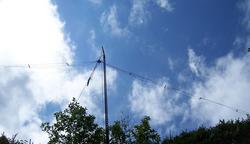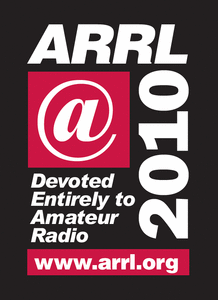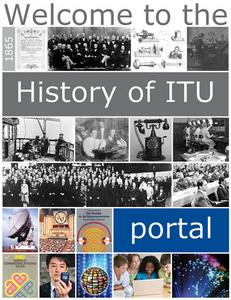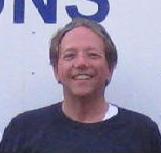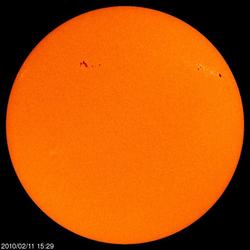 February 11, 2010 John E. Ross, KD8IDJ, Editor
| ||||||||||||||
On-the-Air : Get Ready for the ARRL DX CW Contest
The weekend of February 20-21 will be a busy one for CW operators as the 2010 ARRL DX CW Contest takes center stage. First started in 1929 as the ARRL International Relay Party, the ARRL DX CW contest lays claim to the longest running contest in Amateur Radio. Stations from all around the world -- from Australia to Zimbabwe -- should be active for this great event that takes place on 160-10 meters (contest QSOs are not permitted on 60, 30, 17 or 12 meters). Read more here. ARRL Field Day : 2010 Field Day Packets Now Available
It's that time of year again -- time to start gearing up for ARRL Field Day, June 26-27, 2010! ARRL's flagship operating event -- always held the fourth full weekend in June -- brings together new and experienced hams for 24 hours of operating fun. Field Day packets are now available for download and include the complete rules (including changes for 2010), as well as other reference items such as forms, ARRL Section abbreviation list, entry submission instructions, a Frequently Asked Questions section, guidelines for getting bonus points, instructions for GOTA stations, a kit to publicize your event with the local press and more. Eye on Awards : The IARU Region 2 Award
In October 2009, IARU Region 2 announced a new award -- the IARU Region 2 Award -- available to amateurs and shortwave listeners who submit confirmed QSLs with 20 Region 2 countries or entities. To be considered for the award, contacts must have been made after April 16, 1964 -- the date when IARU Region 2 was founded. Read more here. Hints and Kinks: Unistrut Antenna Support This idea comes to us from Louis Kobet, WB3DZD, of Camas, Washington. When considering a center support for the installation of an inverted V antenna I decided on the following requirements: a strong material, easy assembly, corrosion resistant and with tilt-over capability. The initial design was to use several 10-12 foot sections of antenna mast or 2 inch galvanized pipe coupled together. Due to the cost of antenna mast and galvanized pipe being more than anticipated, an alternative, 10 foot sections of 1-5/8 inch Unistrut channel was selected.
Unistrut is a ham's Tinkertoy. It is available in 13/16, 1 1/4 and 1-5/8 inch widths, 10 and 20 foot lengths and in 12, 14 and 16 gauge sizes. It is made with dipped surface protective treatments from electro-deposition acrylic green to "hot dipped" galvanized coatings and multiple channel designs (including telescoping sections). A vast selection of brackets and fasteners is available and it is continuously slotted for easy guying. The design and choices for project use are limited only by the creativity of the user. The tilt over base support consisted of a treated 4×4 inch landscape post anchored in concrete. (The wooden post was moisture sealed at the top using the dipped coating used for hand tools and along the length with several coats of wood sealer.) The Unistrut mast pivot point on the support base was a 3 inch lag bolt about 50 inches above ground. In retrospect, a section of Unistrut could have been set in the concrete as the antenna base support. The Unistrut mast preparation consisted of black paint (except for areas where the sections were bolted together) and the addition of a hoisting pulley mounted at the end of a 2 foot PVC pipe (see Figure 1). One problem encountered was in bolting the Unistrut together. Bolting back-to-back against the base of the "U" was not possible because I couldn't get a socket on the bolt head inside the Unistrut channel. To get around this the Unistrut was bolted with the open "U" ends face to face. Square Unistrut channel would have eliminated this issue. The three Unistrut sections were bolted together with about a 12 inch overlap.
An antenna hoisting line was fed through the pulley and mast section carried to the base support for mounting. After attaching the mast to the pivot point it was tilted up into position, plumbed and secured in place with three additional lag bolts. The V antenna was spread out, transmission cable attached and hoisted to the top of the mast. The ends of the V antenna were attached to a 12 foot landscape treated 4×4 that was secured to the property fence. Do you have an idea or a simple project that has improved your operating? Maybe you've taken something commonly found around the home and developed a ham radio use for it? Why not share your hints with fellow hams in "Hints and Kinks," a monthly column in QST. If we publish your hint in QST, you will receive $20. Send your hints via e-mail or to ARRL Headquarters, Attn: "Hints and Kinks," 225 Main Street, Newington, CT 06111. Please include your name, call sign, complete mailing address, daytime telephone number and e-mail address. Legislative Happenings: More Cosponsors On Board for HR 2160
Last month, another Congressional Representative -- Jo Bonner (R-AL-1) -- pledged his support for HR 2160, The Amateur Radio Emergency Communications Enhancement Act of 2009, bringing the total number of cosponsors to 34, including original sponsor Sheila Jackson-Lee (D-TX-18). HR 2160 is also sponsored by W. Todd Akin (R-MO-2), Michael Arcuri (D-NY-24), Roscoe Bartlett (R-MD-6), John Boozman (R-AR-3), Madeleine Bordallo (D-Guam), Andre Carson (D-IN-7), Geoff Davis (R-KY-4), Bob Filner (D-CA-51), Scott Garrett (R-NJ-5), Bart Gordon (D-TN-6), Brett Guthrie (R-KY-02), Maurice Hinchey (D-NY-22), Michael Honda (D-CA-15), Mary Jo Kilroy (D-OH-15), Tom Latham (R-IA-4), Zoe Lofgren (D-CA-16), Blaine Luetkemeyer (R-MO-9), Thaddeus McCotter (R-MI-11), Charlie Melancon (D-LA-3), Candice Miller (R-MI-10), Dennis Moore (D-KS-3), John Olver (D-MA-1), Bill Posey (R-FL-15), Dana Rohrabacher (R-CA-46), Bennie Thompson (D-MS-2), Michael Turner (R-OH-3), Peter Welch (D-VT), David Wu (D-OR-1), C.W. Bill Young (R-FL-10) and Don Young (R-AK). Click here for information on how to encourage your Congressional Representative to sponsor HR 2160. PIO News : The February Issue of CONTACT! Now Online
The ARRL is committed to public relations and has built a national PR program designed to represent Amateur Radio to government, the media and the public. The Newington Headquarters' national effort is supported -- and greatly enhanced -- by ARRL public information appointees and other interested volunteers who work to promote Amateur Radio on the local level. One of the tools to help these volunteers is CONTACT, the monthly online newsletter designed to be a resource for ARRL Public Information Coordinators (PIC), Public Information Officers (PIO) and anyone with an interest in Amateur Radio public or media relations activities. Each issue contains helpful articles and tips to help spread the good word about Amateur Radio. The February issue of CONTACT was released earlier this week and is full of information that you can use. With Field Day approaching, how are you going to publicize your club's participation in the largest operating event in the world? Find out what some hams will be doing combine Field Day with other events happening in their communities. Speaking of Field Day, find out how your club can earn 500 bonus points. Learn how a club in New Zealand got people who had no electronics experience excited about Amateur Radio. There's more information in the February issue of CONTACT. You can read it -- as well as other materials prepared specifically to promote Amateur Radio -- on the PIO Web page. New ARRL Web Site Coming Soon
After more than two years of planning, designing and writing, we here at the ARRL are eagerly anticipating the launch of the new ARRL Web site. We've been able to make the online experience easier for our members -- from the online store, to registering for a class, to finding a club -- plus we've created a new, enhanced member profile with many more options available. We've made improvements with you in mind, making sure that we've created the easiest, most enjoyable online experience possible. The new Web site will be available at the end of February. ITU News: ITU Digitizes Historical Archives
The International Telecommunication Union (ITU) announced on February 11 that they have launched the History of ITU portal. This program -- the digitizing of the ITU's archive of historical documents -- aims to improve access to information on the ITU and chart its evolution since its establishment in 1865, while ensuring the long-term preservation of historic documents. The archives will be freely accessible. ITU's Historical Documents Digitization Program is an ongoing project to catalogue and scan key ITU documents and outcomes of major conferences and make them available on the web. Optical character recognition (OCR) allows the documents to be fully searchable. Documents generated from ITU Plenipotentiary Conferences -- as well as from early radio, telegraph and telephone conferences -- are now available on the portal. The portal provides background information, key data and links to the documents and other materials for each conference. The digitization program will continue to make available documents of historic significance, including those related to Radiocommunication Conferences since 1903. Silent Key: Herbert "Pete" Hoover III, W6ZH (SK)
Herbert "Pete" Hoover III, W6ZH (ex-W6APW) -- the grandson of Herbert Hoover, the 31st President of the United States, and the son of former IARU and ARRL President Herbert Hoover Jr, W6ZH (SK) -- passed away February 4, 2010. He was 82. A resident of San Marino, California, Hoover was active in ARRL activities, serving as a Director of the ARRL Foundation in 1976 and as a member of the ARRL Long Range Planning Committee from 1978-1981. In the 1970s, Hoover, along with EIMAC's Bill Eitel, W6UF (SK), established a matching fund to encourage contributions to the amateur satellite program. Hoover served as Vice President and Trustee of the Pasadena (California) Radio Club and was also a member and former President of the Southern California DX Club. In 1978, he was elected to the National Red Cross (later the American Red Cross) Board of Governors. A memorial service is being planned. Donations may be made to Doheney Eye Institute, 1490 San Pablo St, Los Angeles, CA 90033; Hoover Institution, 434 Galvez Mall, Stanford University, Stanford, CA 94305-6010; Herbert Hoover Presidential Library Association, 302 Parkside Dr, West Branch, IA 52358 or the House Ear Institute, 2100 W 3rd St, Los Angeles, CA 90057. Silent Key: Chris Walters, N0HVK, Killed in Connecticut Explosion
Chris Walters, N0HVK, of Florissant, Missouri, was killed in an explosion on Sunday, February 7. He was 48. Walters -- who was employed as a safety manager for an electrical subcontractor at the Kleen Energy Plant in Middletown, Connecticut -- was one of five men killed in the explosion; at least a dozen were injured. The accident received national news coverage. According to officials, the plant was in the process of doing a "blow down" -- clearing the natural gas lines -- when the explosion occurred, but investigators are still determining the cause of the explosion. According to his wife, Fran, Walters was unemployed in Missouri and had been in Connecticut for two months working a temporary job. While in Connecticut, Walters found time to enjoy Amateur Radio activities. He was a member of the Shore Point Amateur Radio Club (SPARC), volunteering for community events and fundraisers with the club; he was also part of SPARC's first ARRL Field Day. Connecticut Governor M. Jodi Rell requested that flags fly at half-staff on February 10 in honor and memory of the five men who perished in the explosion. -- Some information provided by WVIT and SPARC Solar Update
Tad "Light breaks where no Sun shines" Cook, K7RA, reports: The increasing sunspot activity continues, and images from NASA's STEREO mission show a string of active regions in the Sun's northern hemisphere -- both visible and over the horizon on the far side. The high sunspot number for the week was 71 on February 8; the average for the week was 43.3. We haven't reported a weekly average that high since the week of March 27-April 4 in 2008 when it was 43.6. The daily sunspot number hasn't been as high as 71 since May 28, 2006 when it was 78. The earlier reading that reached that level or more was 105 on April 6, 2006. On February 8 -- when the daily sunspot number was 71 -- the total area covered by sunspot activity was 460 millionths of a solar hemisphere. That number hasn't been as high since the same earlier week in 2008 that had a high sunspot number average. The dates were March 26-27 when the area of sunspots was 520 and 510. Look for more information on the ARRL Web site on Friday, February 12. For more information concerning radio propagation, visit the ARRL Technical Information Service Propagation page. This week's "Tad Cookism" brought to you by Dylan Thomas' Light Breaks Where No Sun Shines. This Week on the Radio This week, the NCCC Sprint Ladder is February 12. The YLRL YL-OM Contest is February 12-14 and the FISTS Winter Sprint is February 13. On February 13-14, be sure to check out the CQWW RTTY WPX Contest, the KCJ Topband Contest, the Louisiana QSO Party and the OMISS QSO Party. The North American Sprint (SSB) and the SKCC Weekend Sprint are both February 14. The Classic Exchange (Phone) is February 15 and the AGCW Semi-Automatic Key Evening is February 17. Next week, the ARRL International DX Contest (CW) is February 20-21. There is another NCCC Sprint Ladder on February 19. The Feld Hell Sprint is February 20, the Run for the Bacon QRP Contest is February 22 and the SKCC Sprint is February 24. All dates, unless otherwise stated, are UTC. See the ARRL Contest Branch page, the ARRL Contest Update and the WA7BNM Contest Calendar for more info. Looking for a Special Event station? Be sure to check out the ARRL Special Event Station Web page. ARRL Continuing Education Course Registration
Registration remains open through Sunday, February 21, 2010, for these online course sessions beginning on Friday, March 5, 2010: Amateur Radio Emergency Communications Level 1; Antenna Modeling; Radio Frequency Interference; Antenna Design and Construction; Ham Radio (Technician) License Course; Propagation; Analog Electronics, and Digital Electronics. To learn more, visit the CEP Course Listing page or contact the Continuing Education Program Coordinator. | ||||||||||||||
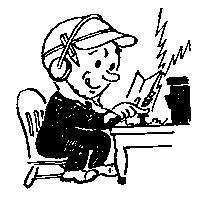
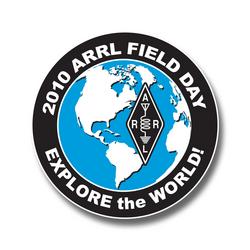
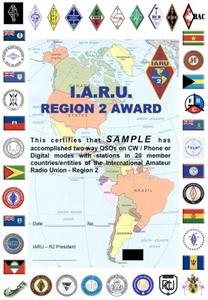
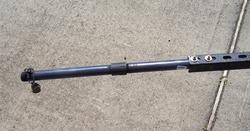 Figure 1: The PVC pipe and hoist pulley device mounted to the top of the Unistrut for hoisting the antenna.
Figure 1: The PVC pipe and hoist pulley device mounted to the top of the Unistrut for hoisting the antenna. 